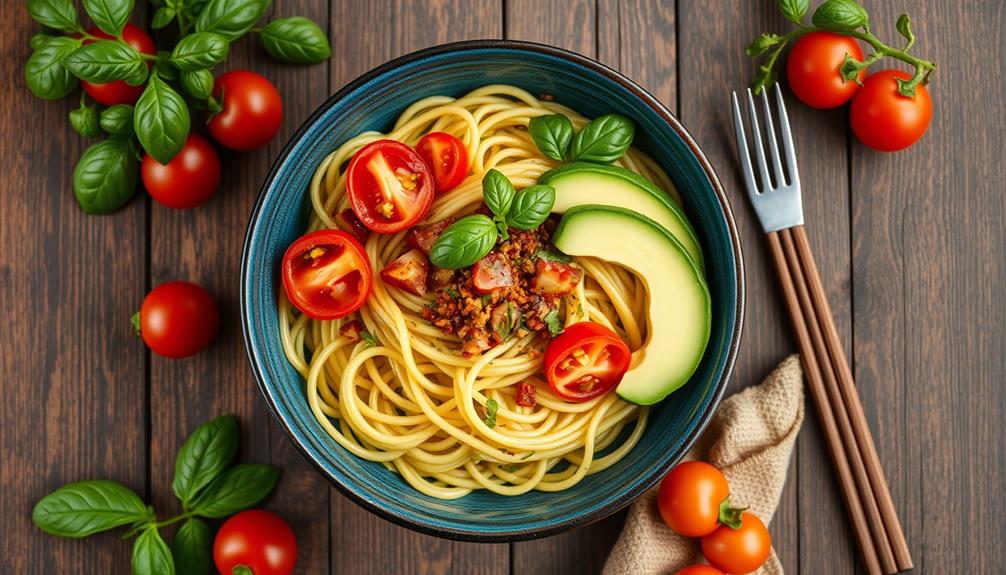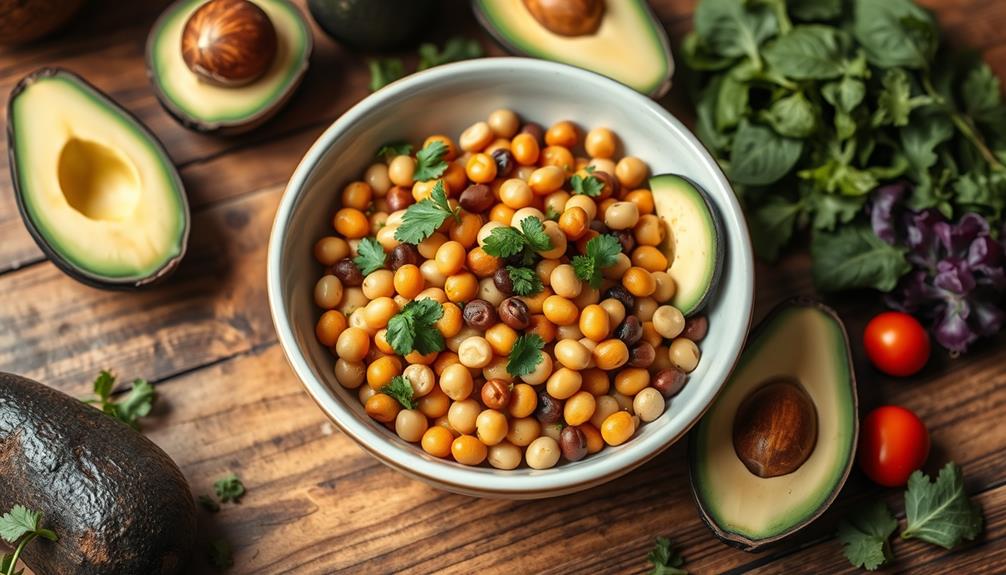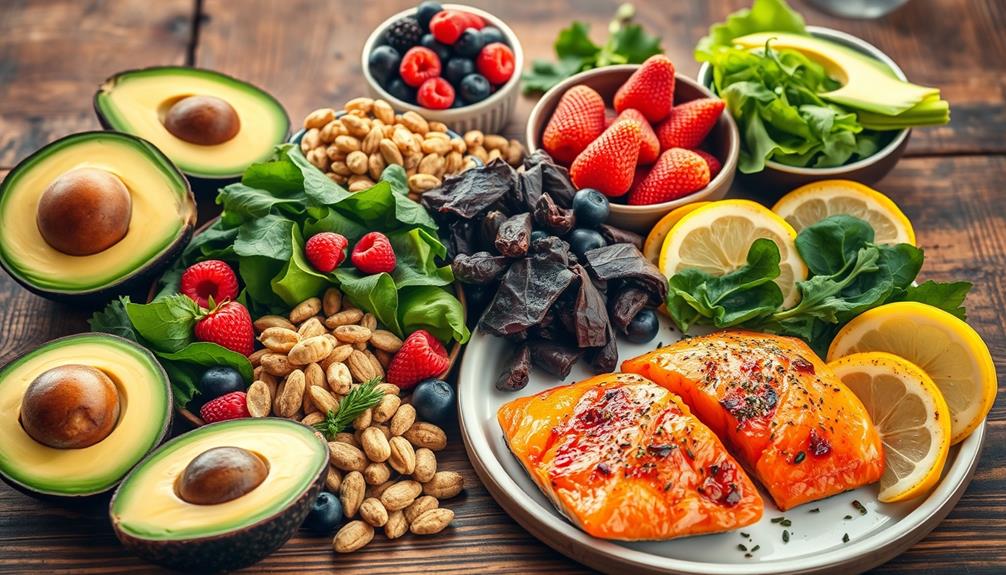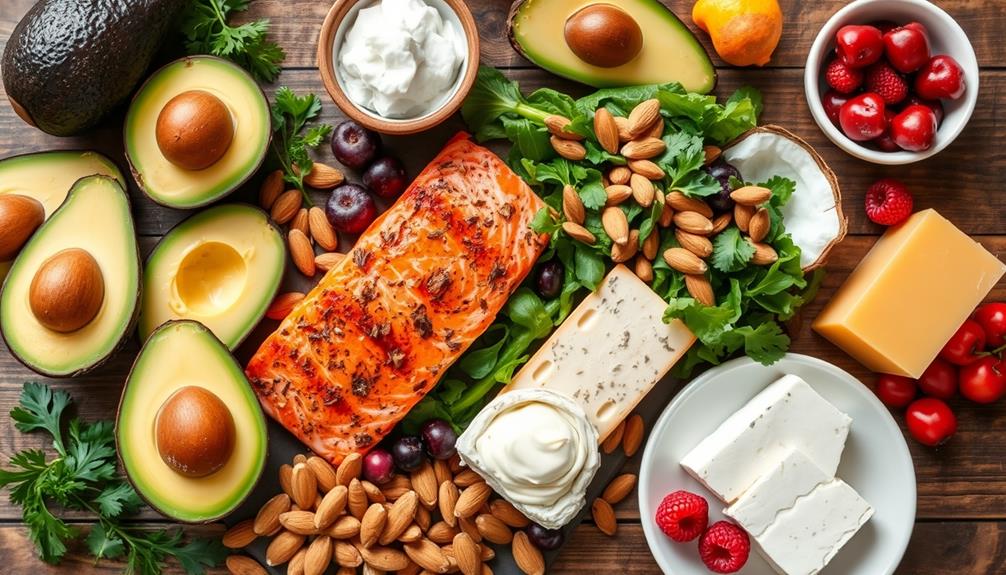The best noodles for a keto diet are low in net carbs and high in fiber, making options like Shirataki noodles perfect since they have zero net carbs. Zoodles (zucchini noodles) and kelp noodles are great too, offering only a few net carbs while providing essential vitamins. If you're looking for a high-protein choice, low-carb egg noodles, made from cream cheese and egg yolks, are ideal. Don't forget about edamame noodles for a versatile option! By choosing these alternatives, you can satisfy your pasta cravings without disrupting your ketosis. You'll want to explore more delicious options, so keep going!
Key Takeaways
- Shirataki noodles are ideal for keto, offering 0 net carbs and very low calories to maintain ketosis.
- Zoodles (zucchini noodles) provide 3 net carbs and add essential fiber and vitamins to meals.
- Kelp noodles contain 1 net carb and are rich in calcium and iron, making them a nutritious low-calorie option.
- Edamame noodles have approximately 5 net carbs and offer a versatile texture with high fiber content.
- Low-carb egg noodles, made from cream cheese and egg yolks, have 1 net carb and are high in protein and healthy fats.
Understanding the Keto Diet
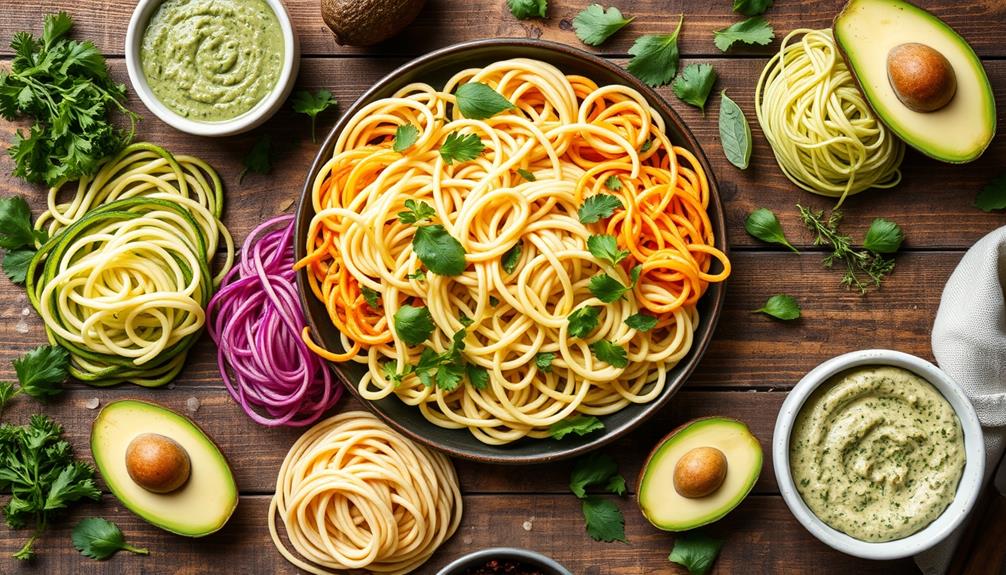
When it comes to the keto diet, many people are drawn to its promise of quick weight loss and increased energy. This high-fat, low-carb approach aims to induce ketosis, a metabolic state where your body burns fat for fuel instead of carbohydrates. Traditional pasta, loaded with carbs, can disrupt this state, making it vital for you to find low carb alternatives.
Incorporating nutrient-rich foods, such as those high in antioxidants, can further enhance your health while on this diet, as they support overall wellness and may aid in effective fat burning rich in antioxidants.
Opting for low carb noodles, such as Shirataki or vegetable-based options like zucchini and spaghetti squash, can help you stay on track. These noodles typically contain fewer than 5 net carbs per serving, allowing you to enjoy your favorite dishes without derailing your progress.
The benefits of the keto diet extend beyond just weight loss; many people report improved energy levels and enhanced brain function due to the use of ketones as an energy source.
Maintaining ketosis requires a balanced intake of nutrient-dense foods, including those low carb noodles that provide fiber and essential vitamins. By incorporating these alternatives into your meals, you can enjoy satisfying pasta dishes while adhering to the keto diet's guidelines.
Best Low-Carb Noodle Types

Finding the right noodles can make all the difference in sticking to your keto diet while still enjoying your favorite pasta dishes. When you're looking for low-carb pasta alternatives, consider Shirataki noodles, which contain 0 net carbs per serving and are incredibly low in calories.
Additionally, incorporating natural remedies, such as gout-friendly foods, can enhance your overall health. Zoodles, or zucchini noodles, are another great option with only 3 net carbs, providing a nutritious boost along with dietary fiber.
Kelp noodles are also a fantastic choice, offering just 1 net carb per serving while being rich in calcium and iron. If you crave something that mimics traditional pasta, try Edamame noodles. With approximately 5 net carbs and a delightful texture, they're versatile for various recipes.
Nutritional Benefits of Keto Noodles
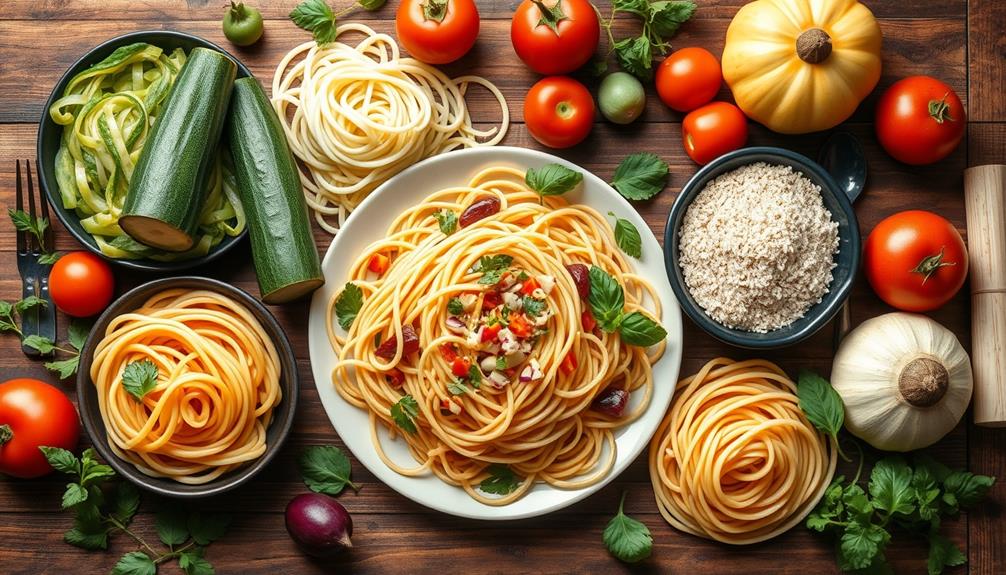
Keto noodles offer a fantastic way to enjoy your favorite pasta dishes without derailing your diet. These low carb pasta options provide a variety of choices that align with your keto lifestyle. For instance, Shirataki noodles contain 0 net carbs per serving and are extremely low in calories, making them perfect for maintaining ketosis.
Incorporating these noodles can make meal preparation easier and more enjoyable, especially when paired with delicious sauces and ingredients. Additionally, many people find that using yoga for back pain can help improve their overall wellness, allowing them to better stick to their dietary goals.
Vegetable-based noodles like zucchini and spaghetti squash usually have just 2-3 net carbs per serving, adding essential vitamins and minerals to your meals.
If you're looking for something a bit heartier, low-carb egg noodles made with cream cheese and egg yolks come in at only 1 net carb per serving and are high in protein and healthy fats. Edamame noodles offer about 5 net carbs and are rich in fiber, allowing you to enjoy a traditional pasta texture while staying within your carb limits.
Many keto noodles are high in fiber, which aids digestion and keeps you feeling full longer, contributing to your overall weight management on the keto diet. With these nutritional benefits, keto noodles are an excellent addition to your low-carb meals.
Popular Keto Noodle Brands
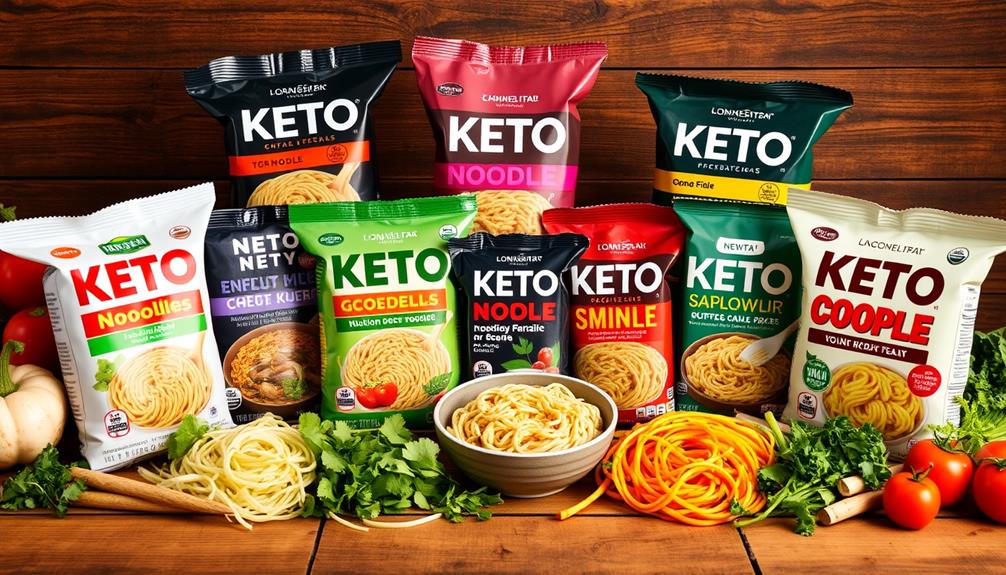
Many people frequently seek out popular keto noodle brands to satisfy their cravings for pasta while sticking to their low-carb lifestyle. Here are some of the best options available:
| Brand | Net Carbs per Serving | Description |
|---|---|---|
| Its Skinny Pasta | 0 | Contains 4.5 calories, ideal for low-calorie diets. |
| Palmini Low Carb Pasta | 4 | Made from hearts of palm, vegan and gluten-free. |
| Banza Chickpea Pasta | 30 | Higher in protein at 20 grams but higher in net carbs. |
| LION KETO Pasta | 0 | Pre-cooked, only 10 calories, easy to prepare. |
| ThinSlim Foods Impastable | 8 | High in fiber with 36 grams, satisfying for keto dieters. |
These keto pasta options cater to various dietary needs, whether you're looking for something low in net carbs or high in protein. With brands like Its Skinny Pasta and LION KETO Pasta, you can enjoy delicious meals without compromising your keto goals. So, when you're craving pasta, these choices can help you stick to your low-carb lifestyle effortlessly.
Cooking Tips for Keto Noodles
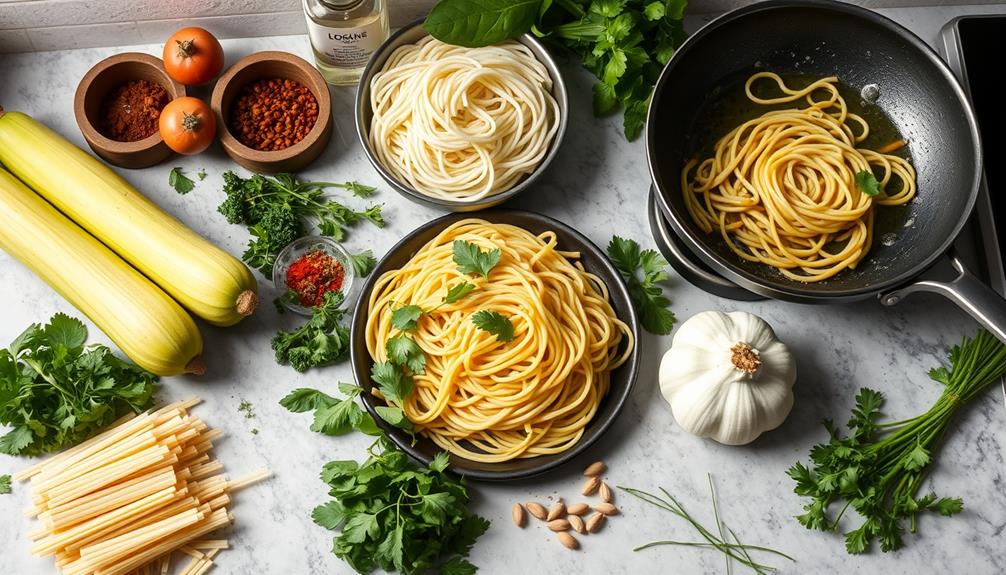
Cooking delicious meals with keto noodles can be a game-changer for your low-carb lifestyle. To get the best texture and taste from shirataki noodles, start by rinsing them thoroughly to remove any residual odor. Boil them for 2-3 minutes before adding them to your dishes.
For vegetable-based noodles like zucchini or cucumber, lightly salt them and let them sit for 15-30 minutes to draw out excess moisture, ensuring a better final texture. Understanding the various cooking methods can greatly enhance your noodle dishes, similar to how different brewing methods affect coffee flavor.
If you're using kelp noodles, sauté them in a mixture of broth and acid, like lemon juice or vinegar, to enhance their flavor. When you opt for low-carb egg noodles, combine them with creamy sauces or stir-fry them quickly with vegetables and protein for a satisfying meal that maintains that traditional pasta feel.
Don't forget about meal prep! Batch cooking keto noodle dishes can save you time during the week. Plus, freezing cooked noodles doesn't compromise their texture, making them a convenient option for future meals.
With these tips, you'll elevate your keto pasta experience!
Delicious Keto Noodle Recipes
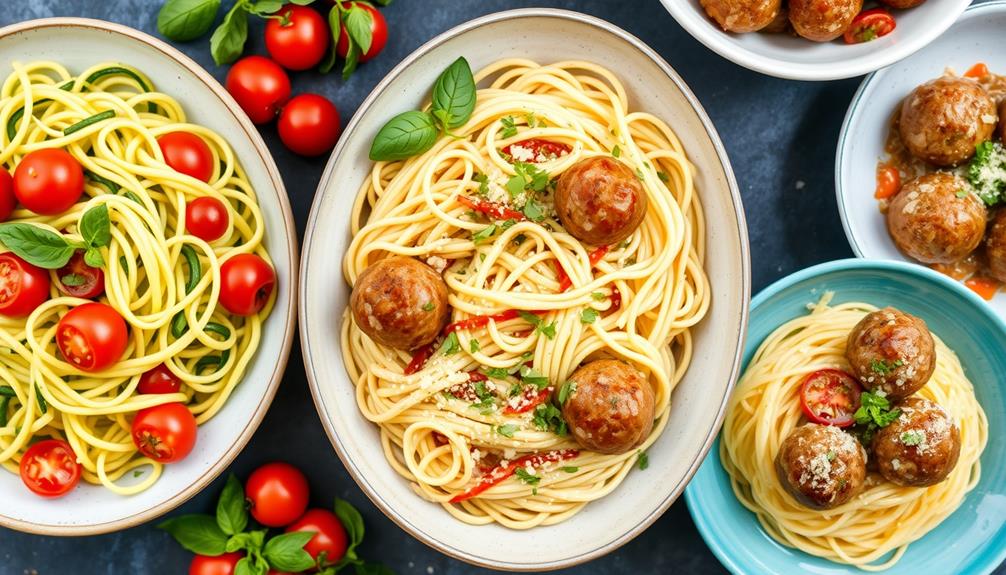
When you're craving a satisfying meal but want to stick to your low-carb goals, delicious keto noodle recipes can be a perfect solution.
Start your culinary journey with Chicken Noodle Ramen featuring Shirataki noodles, which have zero net carbs, making it a comforting, low-carb alternative. Understanding the different brewing methods can enhance your cooking experience as well.
For a twist, try Creamy Pesto Pasta with zucchini noodles (Zoodles) and keto-friendly pesto, delivering rich flavors without the carbs.
If you're in the mood for something spicy, whip up Spicy Mi Goreng using low-carb noodles for a satisfying kick.
For seafood lovers, Seafood Ramen combines shrimp or fish with keto noodles, providing a protein boost while maintaining delicious flavors.
Don't miss out on Braised Pork Belly Ramen; this hearty dish uses keto noodles for a rich, savory meal that keeps carbs to a minimum.
These keto-friendly recipes not only satisfy your cravings but also keep you aligned with your low-carb diet.
Meal Prep With Keto Noodles
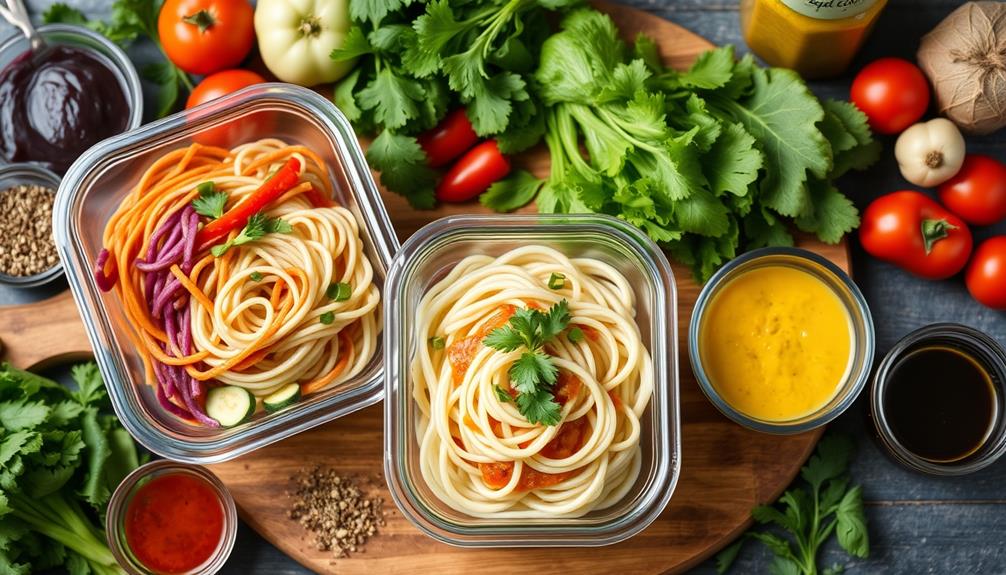
Meal prepping with keto noodles can streamline your week and keep you on track with your low-carb goals. By batch cooking dishes using cooked keto noodles like Shirataki or vegetable-based options, you can save time while enjoying diverse meals.
Plus, these noodles can be frozen without losing their texture, making them perfect for future meals. Incorporating healthy fats and essential oils for health into your dishes can enhance both flavor and nutritional value.
To maintain portion control, pre-portion your meals with keto noodles. This simple step helps you stick to your keto diet and prevents overconsumption.
When meal prepping, think about incorporating a variety of proteins and sauces. This not only enhances flavor but also guarantees you're enjoying a satisfying array of dishes throughout the week.
Leftover cooked keto noodles offer a creative use in salads or cold dishes, giving you easy snack options without sacrificing your carb limits. You can whip up quick, healthy snacks that complement your meal plan.
Embracing meal prep with keto noodles equips you with the tools to effortlessly stay on track while enjoying delicious, low-carb meals. With a little planning, you'll have a week full of satisfying options at your fingertips!
Comparing Noodle Nutritional Values
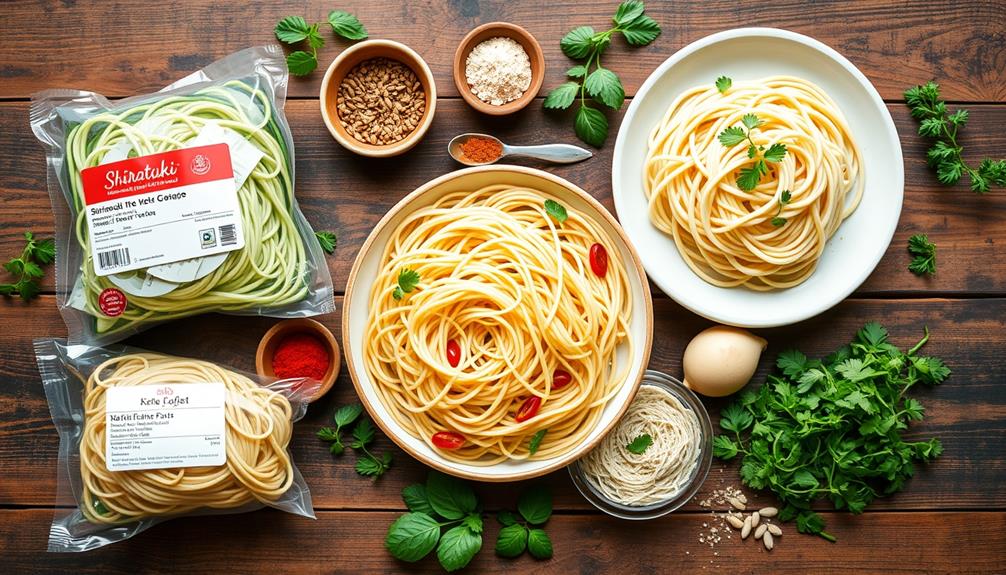
When you're choosing the right noodles for your keto diet, it's essential to compare their nutritional values.
You'll want to look at caloric content, carb counts, and protein levels to find the best fit for your meals.
Let's break down these key factors to help you make an informed decision.
Caloric Content Comparison
Exploring the caloric content of various noodle options can help you make informed choices for your keto diet.
When it comes to low carb alternatives, Its Skinny Pasta is a standout, boasting just 4.5 calories and zero net carbs per serving. If you're looking for a vegan option, Palmini Low Carb Pasta is derived from sustainably sourced hearts of palm, containing 20 calories and 4 grams of carbohydrates per serving.
For a veggie-based alternative to traditional pasta, consider Green Giant Butternut Squash Veggie Spirals, which have 50 calories and 12 grams of carbohydrates.
If you prefer a protein-rich option, Banza Chickpea Pasta offers 190 calories and 32 grams of carbohydrates, along with 14 grams of protein.
On the other hand, LION KETO Pasta is a convenient choice with only 10 calories and zero net carbs, perfect for quick meal preparations.
Carb Counts Overview
Understanding the carb counts of different noodle options is essential for maintaining a successful keto diet. When you're aiming for low carb meals, it's vital to know which noodles fit into your plan. Shirataki noodles stand out as the lowest carb option, boasting 0 net carbs thanks to their konjac yam base.
If you're looking for vegetable-based noodles, zucchini (zoodles) and spaghetti squash are fantastic alternatives, each containing about 3 net carbs per serving, allowing you to enjoy a hearty meal without derailing your diet.
For those who prefer a richer taste, low-carb egg noodles come in at around 1 net carb per serving, primarily made from cream cheese and egg yolks. Kelp noodles also provide a low-calorie option with just 1 net carb, while heart of palm noodles have approximately 1.6 net carbs, making them suitable choices as well.
If you're craving something closer to traditional pasta, edamame noodles offer 5 net carbs per serving and are high in fiber, enhancing your meal's nutritional value. By comparing these options, you can easily maintain your keto diet without sacrificing flavor.
Protein Levels Analysis
Maintaining a keto diet isn't just about keeping carbs low; it's also important to reflect on protein intake, especially if you're aiming for a balanced meal.
When choosing noodles, you'll want to evaluate their protein levels to support your dietary goals. Here's a breakdown of some keto-friendly options: Some great low-carb noodle choices include shirataki noodles, konjac noodles, or zucchini noodles, all of which have minimal impact on blood sugar levels. In addition to focusing on protein levels, you may also want to consider the best keto sweeteners to use in your meals. These sweeteners can help satisfy your sweet tooth while still staying within your keto diet guidelines.
- Banza Chickpea Pasta: 20 grams of protein per serving, making it a top contender.
- Explore Edamame Spaghetti: An impressive 24 grams of protein per serving, ideal for those on a high-protein diet.
- Al Dente Carba-Nada: A solid choice with 16 grams of protein per serving, balancing low net carbs with decent protein content.
- ThinSlim Foods Impastable: Offers 8 grams of protein per serving while remaining low in net carbs, appealing for keto dieters.
- Skinny Konjac Pasta: Unfortunately, it has minimal protein content, often around 1 gram per serving, which isn't great if you're prioritizing protein intake.
Consumer Insights on Keto Noodles
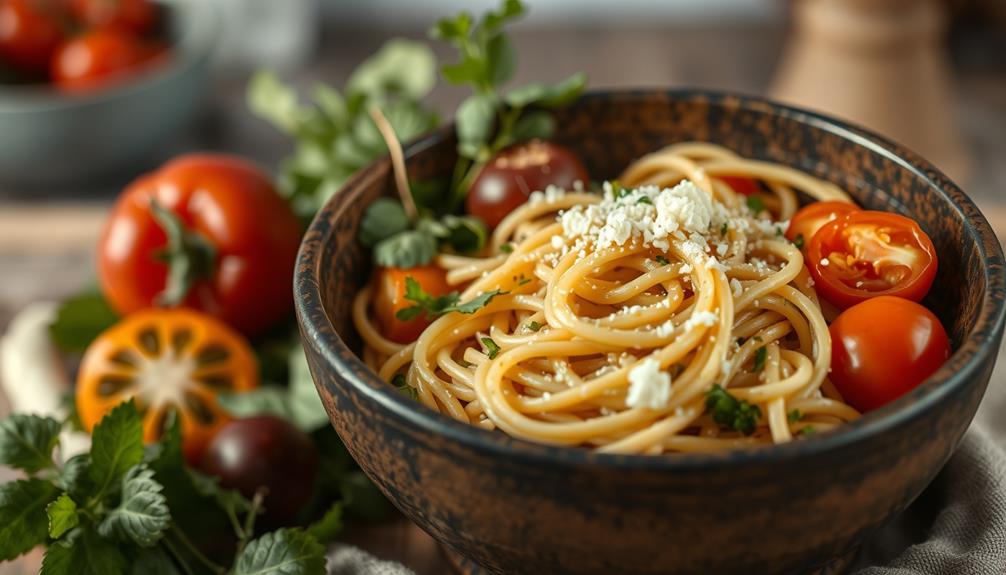
When it comes to choosing keto noodles, consumers are increasingly focused on low net carb content and satisfying flavors. You'll find that options like Its Skinny Pasta, with zero net carbs per serving, are among the best keto noodles for those on a strict low carb diet.
However, taste and texture play vital roles in consumer satisfaction. Some low-carb noodles, like Shirataki, may have a chewy texture that doesn't appeal to everyone.
High fiber content is another important factor. Brands such as ThinSlim Foods Impastable offer an impressive 36 grams of fiber per serving, which can enhance satiety and support digestive health.
Convenience also matters; many people appreciate pre-cooked options like LION KETO Penne, which requires just heating and contains only 10 calories with zero net carbs, making meal prep quick and easy.
Feedback suggests that while noodles like Palmini provide a unique texture, they often need extra seasoning or sauce to make their flavors pop. This highlights how preparation methods notably impact your overall enjoyment of keto noodles.
In the end, balancing low carbs, high fiber, and great taste is key to finding your perfect keto noodle.
Exploring Alternative Noodle Options
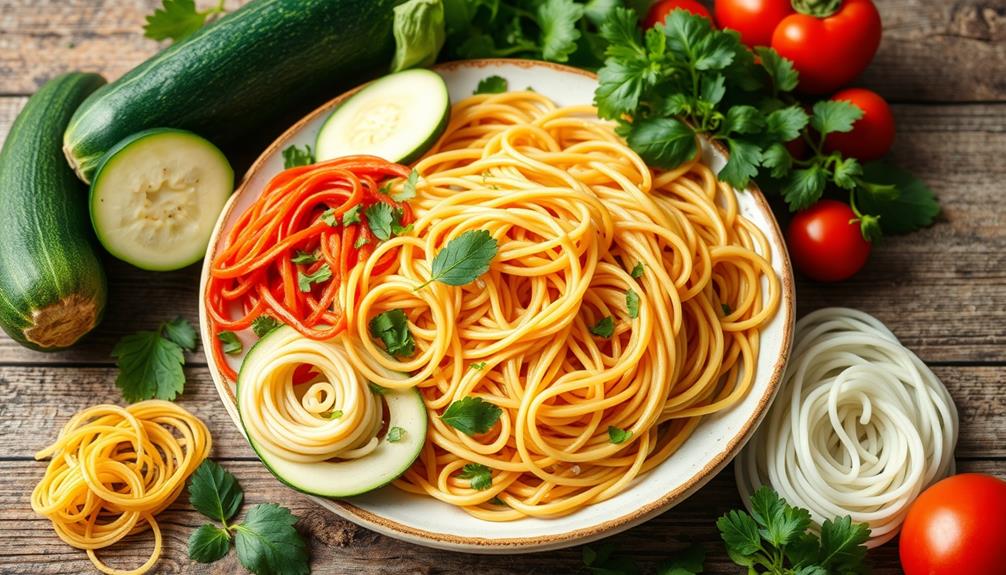
Noodle lovers on a keto diet have plenty of exciting alternatives to traditional pasta. You can enjoy a variety of low-carb options that satisfy your cravings without compromising your dietary goals.
Here are some fantastic alternative noodle options:
- Shirataki noodles: Made from konjac yam, these contain 0 net carbs and are extremely low in calories.
- Vegetable-based noodles: Zucchini noodles (zoodles) and spaghetti squash are great choices, offering only 2-3 net carbs per serving.
- Egg noodles: These can be made with cream cheese and egg yolks, resulting in about 1 net carb and a versatile texture for various recipes.
- Kelp noodles: With just 1 net carb, these are low-calorie and rich in calcium and iron, making them a nutritious alternative.
- Edamame noodles: Providing 5 net carbs, they deliver a texture closest to traditional pasta while fitting perfectly into your keto diet.
Embrace these delicious alternatives and keep your meals satisfying while staying on track with your keto lifestyle!
Frequently Asked Questions
What Kind of Noodles Are OK for Keto?
When considering noodles for your keto meals, opt for shirataki, zucchini, or kelp noodles. They're low in carbs and calories, helping you maintain your diet while still enjoying a pasta-like experience.
What Can I Use Instead of Pasta for a Keto Diet?
Finding alternatives to pasta is like discovering hidden treasures. You can use shirataki, zucchini, kelp, edamame, or heart of palm noodles. Each option offers unique textures and flavors, keeping your meals exciting while staying keto-friendly.
Can You Eat Miracle Noodles on Keto?
Yes, you can eat Miracle Noodles on keto! They're low in calories and carbs, making them perfect for your diet. Just rinse and cook them first to enhance their texture and flavor in your meals.
Are Rice Noodles Ok on Keto?
Rice noodles aren't okay on keto. They're high in carbs, which contradicts the low-carb principle essential for ketosis. Instead, explore alternatives like Shirataki or spiralized veggies to satisfy your noodle cravings without the carb overload.
Conclusion
So, there you have it—your guide to the glorious world of keto noodles! Who knew you could trade spaghetti for zucchini and still feel like a culinary genius? While your friends are drowning in carb-laden pasta, you'll be twirling your low-carb noodles with pride. Remember, life's too short for bland meals, even when you're on a diet. So, grab those keto noodles and embrace your new identity as the "healthy pasta connoisseur" of the group!
